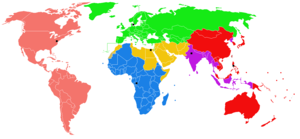 Image via Wikipedia
Image via Wikipedia06/23/2009 08:08 PM
MANILA, Philippines - The race for the still unavailable vaccine against Influenza A(H1N1) virus is on. Affluent countries have made advanced orders for the sought-after vaccine, but the Philippines appears to be dilly-dallying, even after the death of a 49-year-old Filipina who became the first A(H1N1)-related fatality in Asia.
----------
Death of staff with A(H1N1) prompts House closure
The first A(H1N1)-related fatality in the country and in Asia turned out to be an employee of the House of Representatives, which prompted the leadership Tuesday to shut down the Batasan Pambansa complex in Quezon City.
House Speaker Prospero Nograles ordered the suspension of work at the House until Sunday, June 28, for the sanitation of its buildings to be spearheaded by officials from its medical services in coordination with the Department of Health (DOH).
More
----------
“We haven’t placed any order yet because we need to determine the priority group," says Dr. Yolanda Oliveros, director of the Department of Health (DOH)’s National Center for Disease Prevention and Control.
The determination of the group who will first benefit from the vaccine against A(H1N1) is dependent on the country’s goal, according to Oliveros: Will it prioritize public service? Will it focus on economic sustainability, or will it concentrate on minimizing casualties?
“If it is social service, then health workers, policemen, and the military will be the priority. If it’s economic productivity, we will concentrate on working groups. But if the goal is reducing mortality then we will prioritize the very young and the very old," Oliveros says.
The government is still in the assessment stage, and it will take about two more weeks before the DOH’s planning group can identify the priority groups, according to Oliveros.
“You need to balance priorities with existing resources," Oliveros says. She added that the Philippines, as a developing country, is not like affluent nations that can adequately ensure the health needs of their citizens.
Vaccine rush
While the Philippines is dawdling, the rush for the vaccine has started. As early as May, after the World Health Organization (WHO) raised alarm bells about the infection that first struck Mexico, several countries began placing orders with drug companies.
Swiss pharmaceutical giant Novartis reported that it had received requests for the A(H1N1) vaccine from over 30 governments. These requests include a $289-million order placed by the US Department of Health and Human Services.
British health care firm GlaxoSmithKline also announced in May that it had already received intents from several European governments for the stockpiling of the vaccine.
These include 60 million doses for the United Kingdom, 50 million doses for France, 12.6 million doses for Belgium, and 5.3 million doses for Finland.
In June, Australia announced that it would order 10 million doses from the Commonwealth Serum Laboratories.
In Asia, Japan said that it would produce enough vaccine against A(H1N1) to treat 20 million people. In Singapore, the public was ensured of adequate supply of the vaccine, aside from the country’s existing supply contract with a manufacturer.
At the mercy of developed countries?
The scramble for the vaccine has resulted in fears that rich nations could claim most of the limited supply.
WHO director-general Margaret Chan says it’s impossible to produce vaccine for all 6.5 billion people on the planet.
Based on the WHO’s estimate last May, world capacity for producing vaccine against the novel influenza is about two billion doses. If an individual needs two shots for complete immunity, the vaccines will only be enough for 15 individuals in every 100 people.
Sangeeta Shashikant of the non-profit development organization Third World Network earlier claimed that developing countries could be at the mercy of the developed nations, many of which are the world’s top vaccine producers.
“More than 90 percent of the global capacity for vaccine manufacturing is located in Europe and in North America. Developed countries through advanced purchased agreements with manufacturers have already reserved a good portion of the limited current manufacturing capacity. Thus in the event of a pandemic, the world would be several billion doses short of the expected demand," says Shashikant statement.
Early this month, the WHO appealed to producers to donate at least 10 percent of their vaccine to poor countries, where people are more susceptible to the flu.
The WHO appeal apparently did not draw sympathy from all giant drug firms. Novartis said it would not give vaccines for free, but would consider offering discounted prices to poor nations.
“If you want to make production sustainable, you have to create financial incentives," the Financial Times quoted Novartis chief executive Daniel Vasella as saying last June 14.
Should poor countries like the Philippines fear the possibility of unfair access to the much-needed flu vaccine?
An expert from the WHO thinks there’s reason to worry.
“If you impose this kind of restriction to equitable access, then it’s going to be a tremendous burden on how we can control this outbreak," says Dr. Jon K. Andrus, an immunization expert at the Pan American Health Organization, the WHO office for the Americas. - GMANews.TV
From GMANews.tv; see the source article here.










No comments:
Post a Comment